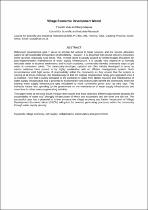JavaScript is disabled for your browser. Some features of this site may not work without it.
- ResearchSpace
- →
- Research Publications/Outputs
- →
- Conference Publications
- →
- View Item
| dc.contributor.author |
Zulu, Mfezeko C

|
|
| dc.contributor.author |
Maposa, Sibonginkosi

|
|
| dc.date.accessioned | 2019-04-03T06:26:06Z | |
| dc.date.available | 2019-04-03T06:26:06Z | |
| dc.date.issued | 2018-10 | |
| dc.identifier.citation | Zulu, M.C. and Maposa, S. 2018. Village Economic Development Model. Out-Of-The-Box Human Settlements Conference, 24-25 October 2018, CSIR, Pretoria, South Africa, pp. 187-194 | en_US |
| dc.identifier.isbn | 978-0-7988-5639-3 | |
| dc.identifier.uri | http://www.sti4shs.co.za/sites/default/files/events/conferences/2018-12/Out-Of-The%20Box%202018%20Conference%20Proceedings.pdf | |
| dc.identifier.uri | http://hdl.handle.net/10204/10912 | |
| dc.description | Paper presented at the Out-Of-The-Box Human Settlements Conference, 24-25 October 2018, CSIR, Pretoria, South Africa | en_US |
| dc.description.abstract | Millennium development goal 7 seeks to provide full access to basic services and the service allocation caters for all households irrespective of affordability. However, it is assumed that service delivery processes come up short, especially rural areas. This, in most cases is usually caused by limited budget allocations for post-implementation maintenance of water supply infrastructure. It is usually very expensive to formally reticulate water in disperse settlements and in such situations, communities develop innovative ways to get water at convenient points. The community-developed systems are often initially developed to serve as interim solutions have proved to be highly sustainable with an efficient management system. Such circumstances instil high sense of responsibility within the community as they ensure that the system is running at all times. However, the disadvantage is that the original infrastructure rarely gets upgraded once it is installed. Time that is purely allocated to the collection of water from distant sources and maintenance of water supply infrastructure has a potential to economically and extramurally benefit the community when the existing water supply infrastructure gets reticulated to more convenient points such as yard taps. This indirectly means less spending by the government on the maintenance of water supply infrastructure and more time for other revenue generating activities. This paper looks at two rural South African case studies that have used two different approaches towards the sustainability of water supply infrastructure of which one succeeded and the other one did not. The successful case has a potential to further enhance the village economy and further introduction of Village Development Economic Model (VEDM) will guide the revenue generating processes within the community through water supply security. | en_US |
| dc.language.iso | en | en_US |
| dc.relation.ispartofseries | Worklist;22090 | |
| dc.subject | Village economy | en_US |
| dc.subject | Self-supply | en_US |
| dc.subject | Collaboration | en_US |
| dc.subject | Communities and government | en_US |
| dc.title | Village Economic Development Model | en_US |
| dc.type | Conference Presentation | en_US |
| dc.identifier.apacitation | Zulu, M. C., & Maposa, S. (2018). Village Economic Development Model. http://hdl.handle.net/10204/10912 | en_ZA |
| dc.identifier.chicagocitation | Zulu, Mfezeko C, and Sibonginkosi Maposa. "Village Economic Development Model." (2018): http://hdl.handle.net/10204/10912 | en_ZA |
| dc.identifier.vancouvercitation | Zulu MC, Maposa S, Village Economic Development Model; 2018. http://hdl.handle.net/10204/10912 . | en_ZA |
| dc.identifier.ris | TY - Conference Presentation AU - Zulu, Mfezeko C AU - Maposa, Sibonginkosi AB - Millennium development goal 7 seeks to provide full access to basic services and the service allocation caters for all households irrespective of affordability. However, it is assumed that service delivery processes come up short, especially rural areas. This, in most cases is usually caused by limited budget allocations for post-implementation maintenance of water supply infrastructure. It is usually very expensive to formally reticulate water in disperse settlements and in such situations, communities develop innovative ways to get water at convenient points. The community-developed systems are often initially developed to serve as interim solutions have proved to be highly sustainable with an efficient management system. Such circumstances instil high sense of responsibility within the community as they ensure that the system is running at all times. However, the disadvantage is that the original infrastructure rarely gets upgraded once it is installed. Time that is purely allocated to the collection of water from distant sources and maintenance of water supply infrastructure has a potential to economically and extramurally benefit the community when the existing water supply infrastructure gets reticulated to more convenient points such as yard taps. This indirectly means less spending by the government on the maintenance of water supply infrastructure and more time for other revenue generating activities. This paper looks at two rural South African case studies that have used two different approaches towards the sustainability of water supply infrastructure of which one succeeded and the other one did not. The successful case has a potential to further enhance the village economy and further introduction of Village Development Economic Model (VEDM) will guide the revenue generating processes within the community through water supply security. DA - 2018-10 DB - ResearchSpace DP - CSIR KW - Village economy KW - Self-supply KW - Collaboration KW - Communities and government LK - https://researchspace.csir.co.za PY - 2018 SM - 978-0-7988-5639-3 T1 - Village Economic Development Model TI - Village Economic Development Model UR - http://hdl.handle.net/10204/10912 ER - | en_ZA |






